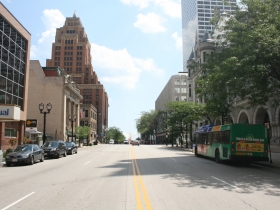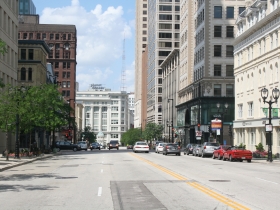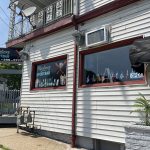The $1 Million Art Project
Steve Marcus’ plan to bring world class sculpture to Milwaukee is expensive. Is it a good idea?
At first glance, Steve Marcus’s proposal to bring world-class public sculpture here for exhibition on Wisconsin Avenue might seem a cheap way to bring great art to a historically thrifty city. After all, the idea envisions internationally-known artists donating their work to be exhibited. But, in fact, to do this right would probably cost in the neighborhood of $1 million a year, as both Marcus and Milwaukee Art Museum director Dan Keegan told me.
Where will the money come from? This is one of many questions that hasn’t been explored. A recent story on the proposed project told readers the downtown business improvement district agreed to work on the project, but that’s the only the beginning to a proposal that could be very difficult to achieve. Marcus compared the idea to the successful Cows on Parade exhibit in Chicago in 1999, but what he is proposing — monumental public sculpture by internationally-known artists — is actually a far more complicated idea. It will take a lot of work — and a major financial commitment from Marcus and the private sector — or it won’t happen.

Looking east down E. Wisconsin Avenue from Jefferson St. Photo taken by Jeramey Jannene on July 18th, 2013. All Rights Reserved.
Marcus said he first began discussing the idea four years ago. His company has a big stake in Downtown, with two hotels on Wisconsin Avenue. The project, he says, “is a piece of the puzzle. How to reinvigorate Wisconsin Avenue. This could get people to come Downtown and see that Downtown is really a nice place to be.”
But years ago, “the timing was lousy, the economy was so bad,” Marcus notes. So he waited, while discussing the idea with others, including Keegan, who had the idea of presenting the art on a rotating basis, as part of an annual, biennial or even triennial exhibition. “The beauty of that is, you hope people will come Downtown at least once every time we change the show,” Marcus notes.
Marcus felt the art museum’s involvement was critical to make sure the exhibition was properly curated. He wanted great art by renowned artists. Visit Milwaukee CEO Paul Upchurch has made a comparison to the art on the Riverwalk, but Marcus notes, “these are not internationally-known artists,” and he and Keegan both emphasize they are aiming much higher. “We want world-class art and it must be well-placed and on the right site,” Keegan says.
But how likely is it that internationally-known artists would loan one of their works for exhibition outdoors for six months (May through October) or so? Keegan points to Manhattan’s public art project, which shows works on loan.
Milwaukee, of course, is not Manhattan, but Keegan and others note that large-sized sculptures are expensive to transport and therefore don’t get shown much. “Sculptors like to see their art placed, so the opportunity to get it shown can be a real advantage for them,” Keegan says. “Galleries would be in the same place” — and thus willing to loan a work they are trying to sell.
But Polly Morris, director of the Lynden Sculpture Garden, says Marcus “may be misled in that internationally-known artists will be willing to lend their work for nothing.” She calls it an intriguing, ambitious idea but says it could encounter a lot of obstacles.
Marcus says the proposition of getting loaned works needs to be tested. “If we were able to establish the feasibility of being able to get the pieces on loan,” then, he says, it might take as little as two years to put together the first exhibition.
“It’s very, very costly to ship and maintain and insure art works, especially large ones and especially large one created by internationally-known artists,” says Jennifer Geigel Mikulay, an Alverno professor and expert in public art.
Then there’s the cost of installing the art. You may need police to block off a street, so a crane can lift the art off a truck and into place, she notes. You need to put down a sculpture pad on which the work is mounted and the sidewalk below this must be strong enough to support all the weight.
Then the process is repeated in reverse when the art work is removed and shipped back. These costs are often overlooked, Geigel Mikulay notes. There are works on the RiverWalk and in the Third Ward that were supposed to be temporary but were never taken down because there was no money for this, she adds. “They wind up getting abandoned or orphaned.”
She also questions whether there is sufficient space on Wisconsin Avenue to properly place large works of art. “Part of how monumental sculptures work is in terms of the space around them. You need the kind of viewing perspectives we associate with monumental art works.”
Moreover, some of the sites on Wisconsin Avenue that might work already have public art installed on them.

Looking west down E. Wisconsin Avenue from Jefferson St. Photo taken by Jeramey Jannene on July 18th, 2013. All Rights Reserved.
All of these issues, as well as the cost, could be somewhat less daunting as you reduce the size of the works. Keegan envisions a mix of art works that might include some smaller sculptures, “new media sculpture” and “projector pieces.” He envisions a committee of curators picking an interesting mix of works, along with citizen participation, with perhaps a “people’s choice” award for each exhibition and perhaps some money allocated to buy one of the works from each festival.
But creating this festival from scratch, and spending enough to market it properly, will still be an expensive proposition. “I think you want to be in the million-dollar range to do it well,” Keegan says. “That’s not an unreasonable number,” Marcus says. Moreover, you’d need a commitment of funding for several years, Keegan adds.
Marcus says he and/or his company will contribute. But he’s clearly hoping for other funders. “The city should be a partner, the county should be a partners, and downtown businesses, art collectors and donors,” Keegan suggests.
But the county is currently trying to reduce its annual contribution to the Milwaukee Art Museum and War Memorial, and the city has been hammered by nearly a decade of huge cuts in state-shared revenue. Ald. Nik Kovac salutes the Marcus proposal as “a great idea” but changes his tune once the issue of city support comes up.
“If you’re talking about a privately-supported project, I’m all in,” he says. “But once you start to talk about public money then we have to get out our list of priorities.” If Kovac is dubious, that’s a bad sign, as he is far more supportive of public art than most members of the Common Council.
Mayor Tom Barrett has indicated his support of the project but hasn’t committed any city money. The city, of course, could provide other key support, from providing a police presence for installing sculptures to handling sidewalk improvements that might be needed to provide proper siting for sculpture. But direct funding of the project by the city seems unlikely.
I’ve been told that Marcus sees this as something that might be his last major legacy to Milwaukee. If so, he may need to make a major gift to make this happen. Even then, this proposal won’t be easy to pull off, but without such a pledge it hasn’t a chance.
Political Contributions Tracker
Displaying political contributions between people mentioned in this story. Learn more.
- March 29, 2017 - Tom Barrett received $1,500 from Steve Marcus
Murphy's Law
-
National Media Discovers Mayor Johnson
 Jul 16th, 2024 by Bruce Murphy
Jul 16th, 2024 by Bruce Murphy
-
Milwaukee Arts Groups in Big Trouble
 Jul 10th, 2024 by Bruce Murphy
Jul 10th, 2024 by Bruce Murphy
-
The Plague of Rising Health Care Costs
 Jul 8th, 2024 by Bruce Murphy
Jul 8th, 2024 by Bruce Murphy




















When I first read about this, my first thought was, “how many top-name artists would be willing to lend their work out for half a year?” Marcus ought to be funding a feasibility study to determine whether there is a pent up supply of monumental art just waiting for a place to be seen. Then, let’s take a look at infrastructure needs and the true costs of installation, policing, insurance and removal. I’m not saying it’s not worth examining, but I wonder if it’s the first place to spend money to bring people downtown. There might be other more efficient ways to spend money that would offer greater returns..
My alma mater actually did something similar on it’s campus: http://www.wmich.edu/art/exhibitions/sculpturetour/
You know, I love art but this seems like a case of misplaced priorities.
I hate to get political but this program is exactly the kind of thing that will get the anti-urban goon squad foaming at the mouth. We don’t need that…. don’t spend any city money on this, there are far, far bigger priorities with better payback in these tight times…
This article would have been a lot more interesting if it talked about ways to get this project done, rather than bring up all the reasons why it may never happen. It’s the old Milwaukee way of thinking…
I love Marcus’ bold ideas and hope he finds support. This should be looked at like the opening of a conversation… perhaps the project goals will morph over time and find the right balance. For instance, how about creating more permanent public sculptures and then rotating out specific pieces?
Portland just recently rolled out a street art program with large illuminated flower-like sculptures that add whimsy and delight to the street at all hours. In many ways it’s illustrative of a city that finds a way to get things done rather than get bogged down by all the hurdles within a complicated project.
Read the article again Chris. Editor Murphy did point out several approaches to getting this done, starting with a big gift from Marcus, just to get things rolling. Then he suggested that private gifts would also be needed, and quite rightly pointed out that the City wouldn’t have the resources to lend financial support. It’s pie in the sky thinking to not point out negatives.
It would be nice if Milwaukee could find its own identity instead of copying ideas from other cities.
I really don’t know much about art or the art world, but if primary objectives – as stated here – are to reinvigorate downtown/ West Wisconsin Ave, to show how nice downtown is, and that downtown is a nice place to be, then I question why there is an emphasis on such expensive and, more importantly, internationally focused interventions.
I do know a thing or two about creative placemaking, and one of the proven essentials to success is to build on the very distinctiveness, history and culture of a specific place. In other words, if we think investing in art is a good strategy (and I think it can be), why don’t we look to our own creative community, for local artists? Building in local stakeholders, with local audiences, will create a ripple effect outward, driving related economic development. This is not about thinking small, and I certainly understand the power of tapping international talent (insert the River Walk or Art Museum here), but I think we miss some powerful community development by not looking inward. I also agree with @Chris, that the temporary nature seems unnecessary. I would think permanent art with some rotating art might better suit our frugal nature and limit the need to compete for scarce funding.
I am intrigued by ideas like Gordon Square Arts District in Cleveland. I could imagine something like this. http://www.gordonsquare.org/about.html
We could weave together the arts institutions along Wisconsin and Water with infill art and art programming that build on what is here. There are many gems already in place up the Avenue and down Water – Riverside, Pabst, currently mothballed theaters, proposed new theaters, PAC, museums, galleries, Grand Ave, Art Milwaukee, etc.
I really support bold thinking and big ideas. Kudos to Marcus for encouraging the conversations.
Well this is interesting. The crusty old capitalist walks out on a public art limb and all the experts start sawing it off behind him. If you want easy public art, go hang out with the Fons. Otherwise, line up with Mr. Marcus and his brilliant, albeit challenging, idea. I sense a turf war here. Could it be that all the public art connoisseurs want their public art curated only by the qualified?
Steve Marcus said:”How to reinvigorate Wisconsin Avenue. This could get people to come Downtown and see that Downtown is really a nice place to be.”
Hey, here’s an idea. How about reinvigorating downtown by getting behind the renovation of that Marcus owned building at 2nd & Wisconsin – the Grand Theater and the office tower above. Nothing says “a really nice place to be” like a vacant 12-story building in the heart of the city. Of course it will take more than a million bucks but that would be a start.
I’m sure this could get traction if the GMC and their young creatives like Jeremy Fojut and Ian Abston get on board
This could be a good idea, or something like it.
But it really seems half baked. Why be so naive? . Where something like this has worked? (I mean the idea of artists donating stuff to a rust-belt city). And as the article points out, Wisconsin Avenue may be the worse place to put public art for a myriad of reasons.
If they have been talking about this for four years, they have been talking to the wrong people
It’s nice but Detroit fell apart, not because of art but because their schools were a disaster as is MPS>
Steve Marcus’s plan isn’t even a proposal so much as it is an idea. A plan would include some sense for how to raise $1M. That said, I’m always a bit irked when people with money come up with ideas like this, want government or quasi-government agencies to entertain them, but never mention that they will fund at least part of it.
It’s too bad this project hasn’t received much love from funding, but perhaps it’s in need of some new minds behind it, or a change of scenery, or some